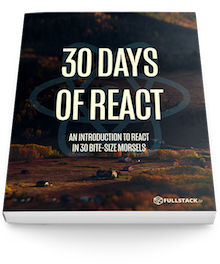Today, we're starting out at the beginning. Let's look at what React is and what makes it tick. We'll discuss why we want to use it.
Over the next 30 days, you'll get a good feel for the various parts of the React web framework and its ecosystem.
Each day in our 30 day adventure will build upon the previous day's materials, so by the end of the series, you'll not only know the terms, concepts, and underpinnings of how the framework works, but be able to use React in your next web application.
Let's get started. We'll start at the very beginning as it's a very good place to start.
What is React?
React is a JavaScript library for building user interfaces. It is the view layer for web applications.
At the heart of all React applications are components. A component is a self-contained module that renders some output. We can write interface elements like a button or an input field as a React component. Components are composable. A component might include one or more other components in its output.
Broadly speaking, to write React apps we write React components that correspond to various interface elements. We then organize these components inside higher-level components which define the structure of our application.
For example, take a form. A form might consist of many interface elements, like input fields, labels, or buttons. Each element inside the form can be written as a React component. We'd then write a higher-level component, the form component itself. The form component would specify the structure of the form and include each of these interface elements inside of it.
Importantly, each component in a React app abides by strict data management principles. Complex, interactive user interfaces often involve complex data and application state. The surface area of React is limited and aimed at giving us the tools to be able to anticipate how our application will look with a given set of circumstances. We dig into these principles later in the course.
Okay, so how do we use it?
React is a JavaScript framework. Using the framework is as
simple as including a JavaScript file in our HTML and using
the React exports in our application's
JavaScript.
For instance, the Hello world example of a React website can be as simple as:
<html>
<head>
<meta charset="utf-8">
<title>Hello world</title>
<!-- Script tags including React -->
<script src="https://cdnjs.cloudflare.com/ajax/libs/react/15.3.1/react.min.js"></script>
<script src="https://cdnjs.cloudflare.com/ajax/libs/react/15.3.1/react-dom.min.js"></script>
<script src="https://unpkg.com/babel-standalone@6/babel.min.js"></script>
</head>
<body>
<div id="app"></div>
<script type="text/babel">
ReactDOM.render(
<h1>Hello world</h1>,
document.querySelector('#app')
);
</script>
</body>
</html>
Although it might look a little scary, the JavaScript code is a single line that dynamically adds Hello world to the page. Note that we only needed to include a handful of JavaScript files to get everything working.
How does it work?
Unlike many of its predecessors, React operates not directly
on the browser's Document Object Model (DOM) immediately,
but on a virtual DOM. That is, rather than
manipulating the document in a browser after
changes to our data (which can be quite slow) it resolves
changes on a DOM built and run entirely in memory. After the
virtual DOM has been updated, React intelligently determines
what changes to make to the actual browser's DOM.
The React Virtual DOM exists entirely in-memory and is a representation of the web browser's DOM. Because of this, when we write a React component, we're not writing directly to the DOM, but we're writing a virtual component that React will turn into the DOM.
In the next article, we'll look at what this means for us as we build our React components and jump into JSX and writing our first real components.




